By Flint Whitlock
Nineteen-year-old Private First Class Peter Gaidosh of East Rochester, NY, was enjoying that rarest of wartime treats—a hot breakfast of fresh eggs, coffee, and pancakes—on the front lines. A member of the 1st squad, 1st platoon, Able Company, 179th Infantry Regiment, 45th Infantry Division “Thunderbirds,” Gaidosh was relaxing on the overcast morning of Friday, September 1, 1944, near the railroad station in the small French city of Meximieux, some 15 miles northeast of Lyon.
To Be Young And In France…
As far as Pete Gaidosh and the other men in his squad—young, battle-tested fellows by the names of Boven, Caverhlo, Comis, Cordova, Frisch, Klock, and Musira—were concerned, it was great to be young and in France, even if there was a war on. Around the kitchen truck the men were relaxing, drinking hot coffee, enjoying a leisurely cigarette, swapping war stories, and chatting about the pretty mademoiselles they had already met, or about the girls they had left behind. Adding to the pleasurable interlude were views of the spectacular Alps along the French-Swiss border a short distance to the east.
The men of the squad considered themselves very lucky. A mere two weeks earlier, on August 15, 1944, they and the rest of the 45th Infantry Division had fought their way ashore during the invasion of southern France along the sunny shores of the French Riviera in an operation called Dragoon.
The Second Allied Invasion
The landing, by Lt. Gen. Alexander M. Patch’s Seventh Army, was intended to complement Operation Overlord, launched two months earlier along the Normandy coast. In addition to the 45th Division, Operation Dragoon involved the participation of the U.S. 3rd and 36th Infantry Divisions, several French units, and the U.S. 1st Special Service Force, popularly known as the Devil’s Brigade. With Allied forces in the north now driving eastward toward Paris, it was expected that Patch’s army, coming up from the south, would squeeze the Germans in a gigantic pincer movement.
There had been intense, if brief, German resistance to Operation Dragoon, but once the Seventh Army had broken through the thin crust of defenses rimming the Riviera, the Americans had made good time. The Seventh Army roared northward, smashing through half-hearted resistance and liberating scores of towns and cities in its path. In the span of a fortnight, the American divisions, traveling in trucks and atop tanks, had traversed over 300 miles, all the while nipping at the heels of General Friedrich Wiese’s retreating Nineteenth Army, which was heading for the Belfort Gap and, ultimately, Germany.
No Rest For The Weary
Like the 3rd and 36th Divisions, the 45th was a war-weary outfit. It had landed in North Africa in time to take part in the invasion of Sicily in July 1943, spent a month in combat on that rocky island, saved the Salerno beachhead from annihilation two months later, then anchored the center of the Allied line at Anzio, where the division had thrown back one furious, fanatical German counterattack after another. But, instead of being allowed to enjoy a long respite in the liberated city of Rome, the Thunderbirds, comprised primarily of the Oklahoma and Colorado National Guard units, were picked for their fourth and final amphibious-combat assault. And now they were spearheading the Seventh Army drive toward Germany.
On August 29, 1944, Maj. Gen. Lucien Truscott, commanding the U.S. VI Corps, had given Maj. Gen. John E. Dahlquist’s 36th Infantry Division the task of securing Valence, Vienne, and Lyon while the 45th Infantry Division, under Maj. Gen. William Eagles, was to rush from Grenoble to Bourg-en-Bresse, some 35 miles northeast of Lyon, to maintain contact with the retreating enemy. Advance elements of the 45th soon discovered that most of the bridges over the Rhône River to the south of Meximieux already had been blown; however, one bridge, between Pont-de-Cheruy and Loyettes, was still intact and was in the hands of a company of French freedom fighters known as the FFI (French Forces of the Interior, or maquis). With no German resistance in the area immediately evident, the 45th’s 179th Infantry Regiment, commanded by Colonel Henry Meyer, was given the assignment of moving swiftly forward to secure Meximieux and supporting the advance of the 45th’s 157th and 180th Regiments northward toward Bourg-en-Bresse.
Deep In the Heart Of the Resistance
Located in the Rhône-Alpes region of southeast France, Meximieux, with a wartime population of about 3,500, was a small, attractive, militarily insignificant town near the Ain and Rhône Rivers, about 50 miles west of the Swiss border. Southwest of Meximieux lies Lyon, France’s third largest city and known then as the “Capital of the Resistance.”
Since Germany could not spare the forces necessary to occupy all of France, which it had conquered in June 1940, Marshal Phillippe Pétain’s collaborative puppet government at Vichy was more than willing to handle this task for Hitler. To make sure the French toed the mark, many cities in Vichy France were overseen by ruthless Nazi officers, and one of the most notorious was SS Obersturmführer (1st Lieutenant) Klaus Barbie who, since November 1942, had run the Gestapo operation in Lyon. Murder, torture, rape, and the deportation of Jews and other “undesirables” to death camps in the east were Barbie’s stock in trade, and a strong underground movement had sprung up in the area, especially in Meximieux, to resist the Nazis.
After having governed the town with an iron fist for many months, the Germans began evacuating Meximieux on August 23 and heading north to form a line of resistance at the Vosges Mountains, much to the great relief of the Meximiards. Alive with resistance fighters, Meximieux had long been a thorn in the Germans’ side, and the Boche were doubly glad to be leaving. A few days before the evacuation, posters printed by the Committee of the Liberation had appeared all over town, directing the Meximiards to strike back at their occupiers.
The Occupied Strike Back At Germans
Indeed, on August 24, a group of 60 FFI commandos attacked a small German outpost and took the hated enemy soldiers prisoner; the German commander was shot trying to escape. The FFI, emboldened now that the Allies were approaching from the south, also did much to destroy German lines of communication, blow up locomotives and tracks, and generally make life miserable for the retreating enemy. As the Germans departed, their positions were taken over by companies of maquisards who planned to hold them until the Americans arrived.
On the day Paris was liberated, August 25, four or five American planes made a bombing run near Meximieux, a sign that the liberators were near. Soon, the church bells were ringing, forbidden French flags (and some home-made American flags as well) appeared in the windows of the town, and the townspeople flooded into the cafés to celebrate.
A Warm Welcome For Liberators Prior To Intense Battle
On August 30 an advance element from the 179th, consisting of one jeep, probed its way into Meximieux where it was immediately swarmed by residents overjoyed at their liberation. One of the Frenchmen recalled, “An American jeep pops out from the road to Charnoz with four men aboard…. The American scouts are surrounded by the crowd. The crowd keeps growing and wishes these soldiers welcome. Solid and smiling, they are perfectly reassuring. They announce the arrival of an American contingent, then they make a tour of the town and disappear. The Meximiards are so happy to welcome the liberators that they have no idea that soon they are going to be in the very heart of the battle.”
The lone scout jeep was soon followed by Colonel Meyer and the 179th’s 2nd Battalion. When they penetrated into the market square at about 1000 hours, the townspeople greeted them with cheers, hugs, and kisses. Marching proudly at the head of the column was a 10-year-old French lad carrying an American flag. The GIs continued through the town and headed up Highway 22 toward Chalamont when, suddenly, two Junkers Ju-87 Stuka dive- bombers appeared at treetop level and strafed the Yank column. The joy of liberation was quickly replaced by fear; the flags and posters came down. Was it just the random act of a desperate, fleeing foe, or could the Germans be returning?
Americans Set Up Defensive Position In Town
With the 2nd Battalion now moving northward, the 179th’s 1st Battalion, under Lt. Col. Michael Davison (who would later command NATO as well as serve as commandant of the U.S. Military Academy at West Point), was relieved of its job of guarding the Ain River bridge, set up its battalion headquarters at the Meximieux railroad station, and began establishing defensive positions in the unlikely event the Germans returned. The 3rd Battalion would remain in the rear to bolster the maquis fighters guarding the bridge at Loyettes and secure the vital American supply lines.
Davison’s battalion was drastically understrength—down to just A and D Companies, HQ Company, and two M-10 tank destroyers—having loaned out B Company to reinforce the 2nd Battalion’s push to Chalamont and leaving C Company south of town, guarding the rear. No one thought it would be a problem, for the Germans seemed to be in full retreat and intelligence had not spotted any attempt by the enemy to mount a counteroffensive.
If any German threat existed, Colonel Preston J.C. Murphy, the regiment’s executive officer, with his headquarters established in the seminary a block north of the railroad station, assumed it would come from the direction of Lyon, and he deployed F Company to cover that avenue of approach.
German “Ghost Division” Prepares For Full-Scale Counterattack
Unknown to the Americans or the French, a strong German rear guard was preparing to smash Allied positions in and around Meximieux and at Pont d’Ain. General Friedrich Wiese had ordered General Wend von Wietersheim’s 11th Panzer Division—the fabled “Ghost Division”—to mount a major effort to dislodge the Americans from Meximieux and its environs. Prepared to launch the main attack was a Kampfgruppe (battle group) made up of elements of the 15th Panzer Regiment, 209th Panzer Regiment, and 111th Panzer Grenadier Regiment of von Wietersheim’s 11th Panzer Division. This was no mere delaying action by a retreating enemy; a full-scale counterattack was in the works.
The first blow was struck on the afternoon of August 31. F Company, 179th, at a roadblock on Highway 84 about five miles west of Meximieux, now came under heavy assault by tanks and infantry. A hundred FFI men rushed to the aid of the Yanks but it was no contest; the Germans overran the position and captured most of the 300 defenders. The road to Meximieux was wide open.
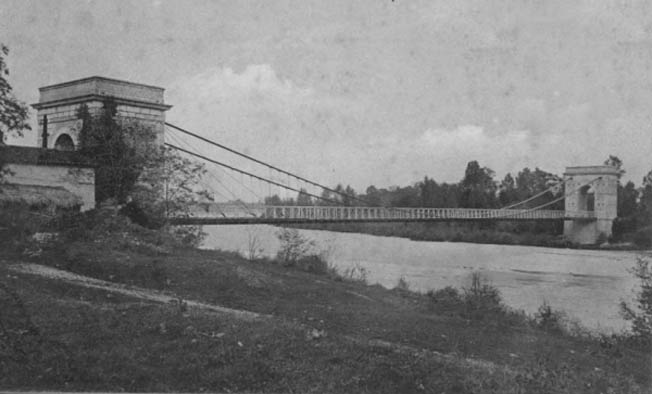
By nightfall the Germans had almost completely encircled Meximieux; indeed, before dawn on the morning of September 1, some enemy troops had already infiltrated into town and had taken up positions in preparation for the coming battle. As the day broke, the battle began.
GIs Caught By Complete Surprise
Lieutenant Colonel Davison, commanding the 179th’s 1st Battalion, recalled, “On 1 September, around 0900, the Kampfgruppe attacked Meximieux from the northeast and the south.”
One of the men in Gaidosh’s company, Uther Gruggett, a corporal and the platoon sergeant of the 3rd Platoon, recalled that he had piled his mess kit with hotcakes at the kitchen truck and “had just returned to my fart sack, sat down to begin eating and reading a letter from home, when all hell broke loose. I heard German machine guns open up. There was no mistake as to whether they were German, as they fired so fast it sounded like a GI with a good case of the GI’s. They caught Company A with our pants down. There was no time for the squad leaders to gather the troops together—it was every man on his own.”
German machine-gun fire swept the streets, mortar rounds fell from the sky, and the guns of the tanks belched fire, sending shrapnel and pieces of brick, stone, and glass everywhere; the town was being torn apart. For hours, screams and yells in English, German, and French filled the air, and the panicked civilians burrowed deeply into the recesses of their homes and cellars. No one could tell who was winning the fight, how long it might last, or what would be left of their picturesque city once it ended. The tiny infirmary at the seminary where Colonel Murphy had established regimental headquarters was soon filled to overflowing with the wounded and dying.
No Quarter Asked Or Given
Panzer grenadiers made their way through the storm of flying lead, heading for Davison’s command post at the railroad station. As the enemy drew ever closer, Davison radioed Murphy for reinforcements; what few extra men he could spare—the cooks and clerks—Murphy sent to the station. The fighting was now hand-to-hand, with no quarter asked or given. With great effort the Yanks forced back the Germans, who retreated, leaving their dead and dying comrades sprawled on the cobblestones.
Robert Fitzpatrick, a platoon sergeant in D Company’s mortar platoon, recalled that several members of the company kitchen staff were taken prisoner early in the fighting. One of them, Curtis Hill, had tried to avoid capture, but without success. After crawling into weeds, Fitzpatrick said, “he thought he was home free but when he raised his head, a group of German soldiers was standing there, watching him. He was put on a German tank that was later hit and put out of action. He was knocked off the tank and took refuge behind the concrete base of a porch.” The Germans fired at Hill but he managed to crawl to the opposite side of the porch where the Americans, thinking he was a German, also began shooting at him. “Somebody saw he was a GI and called for him, so he made a break for it and rejoined our side.”
French Join Americans In The Fight
Meanwhile, back in Meximieux, the battle was increasing in ferocity. A maquis officer known as Captain Clin reported to Colonel Murphy’s headquarters in the seminary and offered his small band of fighters to help the Americans. Outnumbered by the Germans two to one, Murphy gratefully accepted all the help he could get. With the FFI at their side, the Thunderbirds would stand and fight.
Another German assault was building to the south of Meximieux, and Davison’s men, carrying only bazookas and rifles, rushed to face this new danger. Fortunately, forward observers in the seminary’s steeple had seen the threat and radioed the coordinates to the American howitzers at Charnoz, three miles southeast of Meximieux.
Running A Gauntlet Of Enemy Fire
The guns unleashed a hellish barrage that broke up the combined infantry-armor attack, not only to the south of Meximieux, but all around it. The Morning Report of the 189th Field Artillery Battalion stated, “At approximately 1100, a strong force of enemy tanks and infantry attacked road blocks northeast, north, northwest, southwest, and south of the Battery A position [on the far side of the Ain River, where it was attached to Battery B of the 160th FA Battalion], thus forming almost a complete ring around a wide area on three sides of Meximieux, and at some points coming between the battery position and the infantry. The battery kept on firing until afternoon when a message was dropped from a liaison plane saying that enemy tanks were approaching little more than 1000 yards away…. The four guns of Battery A fired 223 rounds of HE [high explosive] and 20 smoke in meeting the attack.
“After the attack had begun, ammunition at the battery position was running low. The battery ammunition train, plus three trucks of Service Battery attached to Battery A, were dispatched down the only available highway, even though it was doubtful if the road was still in possession of our troops. The train got through. On the return trip, the train had to cross the bridge at Loyette, which was under heavy enemy rocket fire. An officer at the bridge stopped the convoy, inquired its destination, and upon learning that Battery A was near Meximieux, told the drivers there was nothing but enemy troops in that area since the enemy breakthrough. The train moved on regardless, and safely ran the gauntlet of enemy fire back to Battery A with the much-needed ammunition, arriving at the position at about the time when the enemy was closest. It was a trying time for Battery A, but every man responded superbly….”
Six German Tanks Approaching; Only Two Tank Destroyers Left
One by one, the Tigers and Panthers and Mark IIIs erupted in flame; crew members who tried to escape were picked off by American sharpshooters. The accompanying panzer grenadiers were similarly gunned down; the survivors fled.
The battle for Meximieux now reached its critical phase. An observer in a church steeple warned that enemy tanks were approaching from east and west. With only two tank destroyers available to defend the town against dozens of panzers, Davison made a bold decision. He placed them in front of City Hall on Geneve Street, their muzzles pointing in opposite directions.
Davison recalled, “At midday, we observed six German tanks, each carrying some infantry soldiers, approaching the town…. I had two tank destroyers [TDs] attached to my battalion and had stationed them back to back in the center of town at the main road junction, prepared to deal with an enemy armor penetration from any direction, or to move to a specified point on the perimeter of town, as needed. The six German tanks did indeed penetrate. Our soldiers took care of most of the riflemen riding on the tanks as the tanks swept into town. But, as they approached the center of town, the TDs knocked out the first three tanks.”
Tank Destroyers Hit Their Marks
A 3-inch shell from one of the TDs blew the track off the first panzer, immobilizing it. A second tank, a Panther, fired a shell into the steeple of a church, killing the observer, and then was itself destroyed by a bazooka round. The burning tank continued on for a few more yards before crashing into the lobby of the Hotel Lion d’Or; a gasoline pump was crushed in the action and the whole block was set ablaze. Attempting to escape their burning tank, the crewmen were shot down. The second TD spotted another Panther coming from the opposite direction, fired, and disabled it. The panzer spun 180 degrees and crushed a civilian.
Two more Panthers, plus two monstrous, self-propelled 150mm guns, approached the TDs. The Panthers accelerated down the street toward the TDs. Davison said, “Two of the remaining three tanks rushed by the TDs; one was knocked out by bazooka fire and the other took a direct hit on top of the turret from an 81mm mortar round fired by D Company. It set off the ammo in the tank. The sixth tank withdrew from town.”
The tracked guns veered off to the south, evidently trying to outflank the TDs, but became lost in the maze of narrow streets until they, too, fell victim to American marksmanship, this time by bazookas.
Going “Tiger Hunting”
Lee Treft, the supply sergeant for A Company, 179th Infantry, along with a fellow soldier, witnessed the panzer-led assault. “Two tanks came out [of the woods near town] and opened fire. We took off running to a wall behind us. They fired and hit the wall and made a big hole in it. We went through the hole and over the wall on the other side. There was a railroad there and a small bridge. We got under there and not long after there were Germans all around us. They never did look under the bridge, and we were there 19 hours.”
One soldier who did not miss the fighting was Pfc. Robert A. Schmuhl, A Company, 179th Infantry. Acting without orders, Schmuhl, his buddy Herb Mucklow, and three or four others marched to the sounds of the guns, which were not far off. “We were aware of the armor fighting in the center of the village. We had no anti-tank weapons with us. We had only rifles. Herb and I went back toward the center of town, on our side of the east-west street, in search of some weapons. We located a bazooka and two rounds as well as a rifle grenade launcher with an anti-tank grenade, then we headed back to our position. Someone asked us what we were doing and I, in my smart-mouth way, said we were going ‘tiger hunting.’”
Everyone Pitches In To Battle German Tanks
Pete Gaidosh also recalled the duel between panzers and tank destroyers near the center of town. “Six tanks with infantry aboard rumbled into town from the south, continued under heavy fire which dispersed their riders, and turned into the main street heading for city hall. The first tank was knocked out by our TD and burst into flames. Then the second was hit. The third and fourth got into high gear and charged the TD, scraping the paint as they went, but the other TD knocked out Number 3. Number 4 went by the TD; I’m not sure what happened to Number 5. Meanwhile, the TD reloaded and hit Number 4, and D Company destroyed Number 6 with a mortar. Another tank was coming from the east and was hit and retreated toward the others that stood guard but did not enter.”
Sergeant Robert Fitzpatrick, D Company, also did his part to turn back the enemy tanks. He rushed to the top floor of a large house from where he could direct the fire of his four 81mm mortars. “I had my four 81s set up in the yard and at times we were firing in four different directions at the same time. At one time, a German tank was stopped next to a stone fence two or three blocks away and firing a machine gun down the street. I couldn’t see it but could tell about where it was, so I directed several ‘HE-Heavy’ rounds toward it. Two or three sent up dust clouds around the tank and then we got a direct hit that put it out of action.”
Robert B. Jackson, a jeep driver in D Company, had a ringside seat to the action; peering out a window near the panzer, he observed Fitzpatrick’s kill. “The range was so short that we pulled all the increments and just lobbed the rounds. We were really excited when the kill was confirmed. It is not very often that an 81mm crew can know results for sure.”
Firing Into the Tiger’s Belly
Schmuhl and Mucklow continued their tiger hunt. “As we approached the street on the eastern edge of town,” Schmuhl recounted, “we heard armor coming down the main street. There was a small alley between two houses leading from the street we were on to the main street. It was about five feet wide. I knelt at the edge of the street with the bazooka while Herb loaded the rocket and affixed the wires. Just at that time some German tanks came by with soldiers riding. I fired the bazooka and hit the last tank as it passed. I don’t know where the round hit, but the tank advanced a few yards and stopped out of our view.”
Schmuhl and Mucklow beat a hasty retreat and rejoined the rest of their squad, but soon came upon another enemy tank. “It was snuggled next to a high stone wall which bounded a hilly field on the edge of town,” Schmuhl said. “A farmer’s barn opened up to the field. We entered the farmer’s walled courtyard, which was on the street level. I looked through a crack in the courtyard’s wooden equipment gate and saw an enemy tank to the left.” The two GIs cautiously approached the stationary panzer and climbed atop a retaining wall. “Looking over the wall, I peered directly down into the tank turret. The tank commander was talking on the radio.”
Mucklow again loaded the bazooka, and Schmuhl took aim and fired—nothing happened! “I knelt back down and picked up my rifle on which I had placed the grenade launcher, grenade, and blank shell casing. I pulled the pin, leaned over the parapet, and fired into the tank turret.” Following the explosion, the two GIs hightailed it back to the temporary safety of the barn.
Lone American Takes Out Five Germans With Tommy Gun
During the armor battle in the center of town, panzer grenadiers infiltrated the northern part of town, only to be gunned down in the streets and yards by Americans and maquisards. A Frenchman described one incident. “A five-man German commando unit attempted to break through in the direction of Mr. Ramel’s cellar, where 50 civilians, full of apprehension, had taken refuge. They are protected by one lone American soldier. This man displays an unbelievable amount of self-control and coolness…. Crouched behind a stack of wood in the courtyard which hides access to the cellar, this American soldier cuts down, one after another, these five Germans with his Thompson submachine gun.”
Seeing that his armor attacks were ending in disaster, von Wietersheim called off the panzers and sent them heading northeast, in the direction of Pont-d’Ain. The German infantry, however, was making headway, first routing American and FFI fighters from an imposing chateau on the outskirts of town, then assaulting the seminary, where so many wounded troops—friend and foe alike—had been taken, and where Colonel Murphy and Captain Clin had their headquarters. A French account said that the Germans presented Murphy with an ultimatum—surrender or the seminary would be blown up. Although he knew that reinforcements were on their way, he had no idea when they would arrive.
A Call for German Surrender Rebuffed With A Hail Of Bullets
Murphy rejected the surrender demand and stationed his 150 remaining men, along with Clin’s equal number, at the doors and windows of the seminary in preparation for an all-out German assault. When the infantry did attempt to rush the building, the attack was greeted with a hailstorm of bullets, and the enemy backed off.
Lieutenant Colonel Davison said, “We identified four to six additional tanks, but they remained outside of town and our artillery damaged three of them. Sporadic fighting around the perimeter continued until nightfall, when the Kampfgruppe began to withdraw from the area. By daylight the next morning, Meximieux was again secure. The Kampfgruppe had failed in its mission to drive us back from our position holding the road on the flank of the retreating Nineteenth German Army, and enabling our forces to race north, maintaining pressure on them.”
As a gray dawn lightened the sky, the Meximiards began to emerge from their hiding places and inspect their town, which had been left a shattered ruin. Here and there, dead bodies littered the rubble-strewn streets, and buildings and armored vehicles continued to burn. Hanging out of the turret of the panzer that crashed into the Hotel Lion d’Or was the charred skeleton of the tank commander. Robert Fitzpatrick also saw the panzer that his mortarmen had hit. “There was one dead German on the deck and one hanging halfway out the turret. There may have been others inside,” he reported.
In the Aftermath
Almost as a way of asking forgiveness for the destruction that had come to Meximieux, the Americans came forth with food and water for the stunned, frightened residents.
Remarkably, American casualties had been light. The official Army history states that the 179th lost three killed, 27 wounded, and 185 missing, presumed captured, while the attacking Germans had suffered considerably heavier losses: 85 dead, many more wounded, and 41 POWs. In addition, eight medium and four light panzers, three self-propelled guns, and seven other vehicles had been knocked out, and four mortars and four machine guns were captured. Some 28 civilian Meximiards also perished, but the town was at last free; the enemy would never come this way again.
On the morning of September 2, when all was quiet, Lee Treft, still hiding beneath a railroad bridge, saw another GI from A Company, Andy Cordova, advancing down the railroad track, grenade in hand. “He had pulled the pin,” said Treft, “and was ready to throw the grenade under the bridge when I called, ‘Cordova!’ He threw the grenade over the tracks and said, ‘What are you doing here?’” Treft explained that he had been there for 19 hours. Cordova commented that Treft had missed all the fighting. “We got out from under the bridge and there were five German tanks smoking.”
Much Accomplished With So Little
Davison had high praise for those who turned back the German assault. “All of this was accomplished by a battalion minus two rifle companies; a couple of TDs; the clerks, cooks, and drivers of regimental headquarters; and our supporting artillery. An important element in the successful defense of Meximieux was a group of about 150 French Forces of the Interior that joined with us in the fight and performed superbly.”
For the men of the 45th, the end of the battle did not mean the end of the war. There were still hundreds of miles to go, from Meximieux to the German-held Maginot Line and, across the border, the Westwall, or Siegfried Line, where terrible fighting would take place at the end of 1944. Once through the defensive strongholds, the 45th, along with the rest of Patch’s Seventh Army and Lt. Gen. George S. Patton, Jr.’s Third Army, would race eastward through the heart of Germany, smashing through every roadblock and resistance point the Germans could throw in their way.
The Thunderbirds would not stop until they had liberated the Dachau concentration camp and helped take Munich at war’s end.
Memories And Plaques Are All That Remain
Today, the town of Meximieux, population 7,000, has been restored and rebuilt to its prewar charm, with little hint of the terrible fighting that once swirled through its streets. Yet, here and there, plaques and markers commemorate the battle and pay homage to those who lost their lives on September 1-2, 1944. And, in one amazing piece of irony, when Michael Davison, in 1962, was promoted to four-star general and commander of NATO, the military attaché assigned to him from the West German Bundeswehr was one of the officers who had fought against him and his troops at Meximieux.
With 511 days of combat, the 45th Infantry Division’s battle for Meximieux was just one small chapter in a very long history. For the men who fought there and survived, however, it remained permanently etched in their minds as an example of no matter how unfair the odds or dangerous the situation, the American fighting man in World War II was more than equal to the challenge.
Originally published Aug 21, 2015
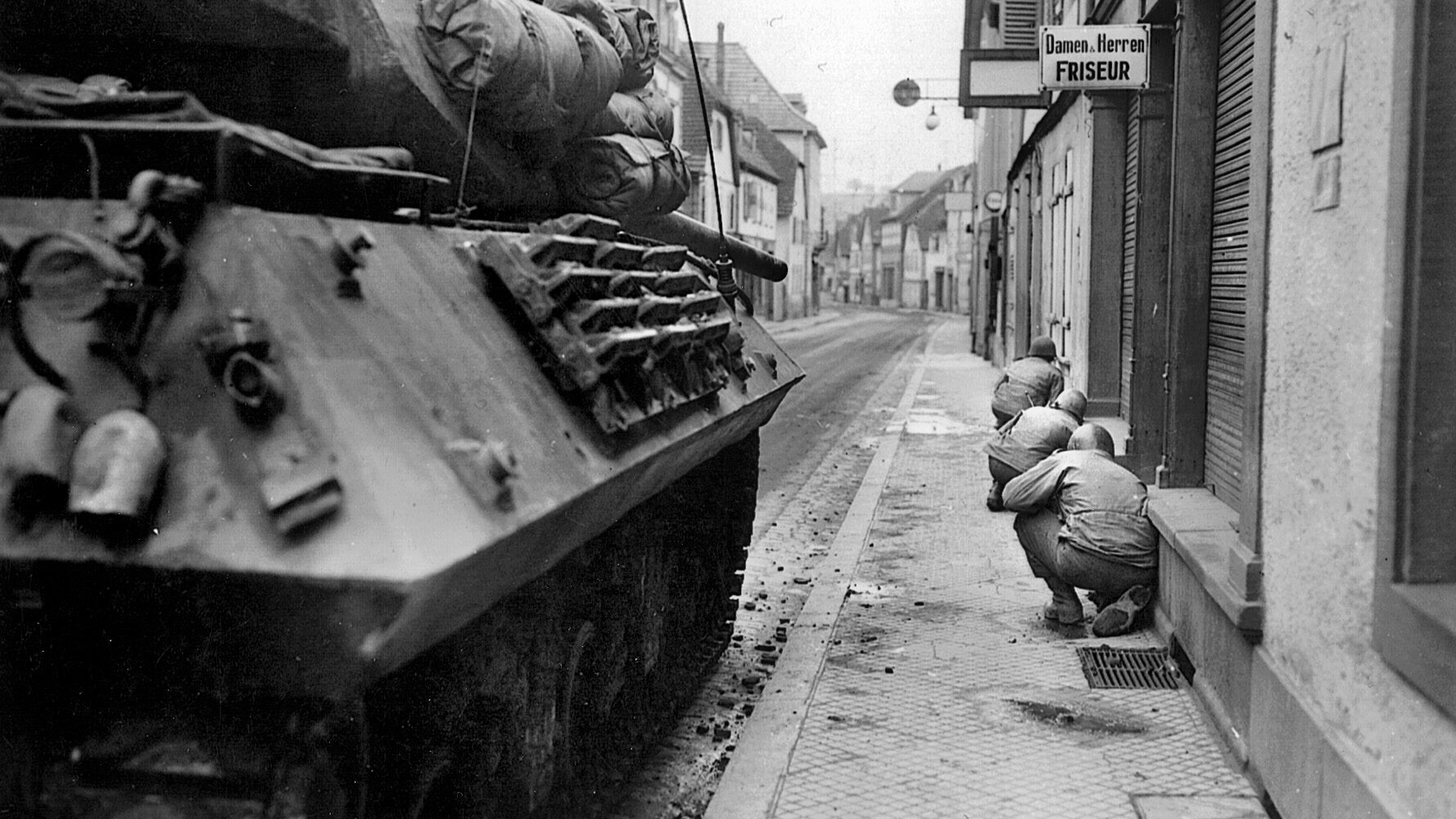
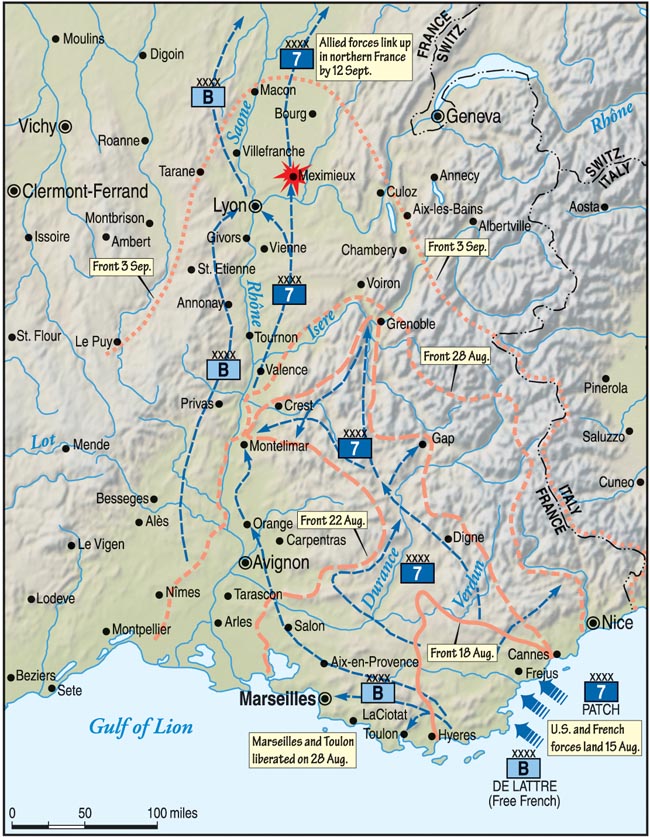
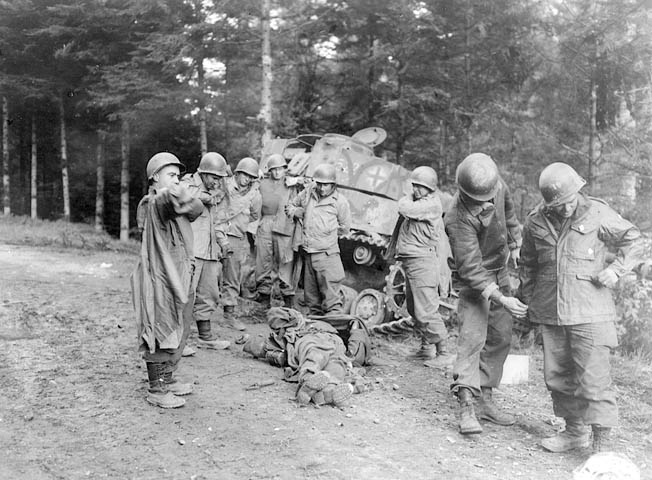
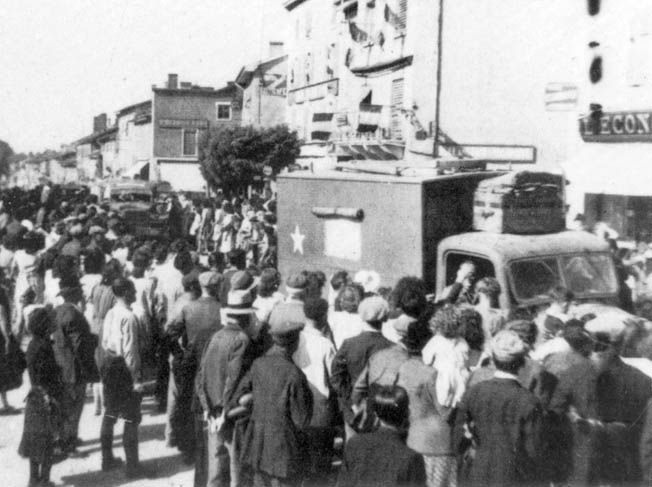
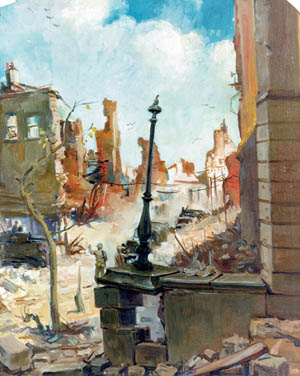
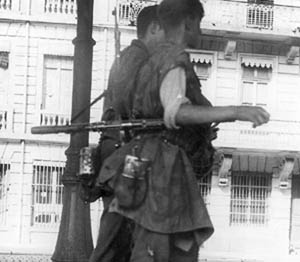
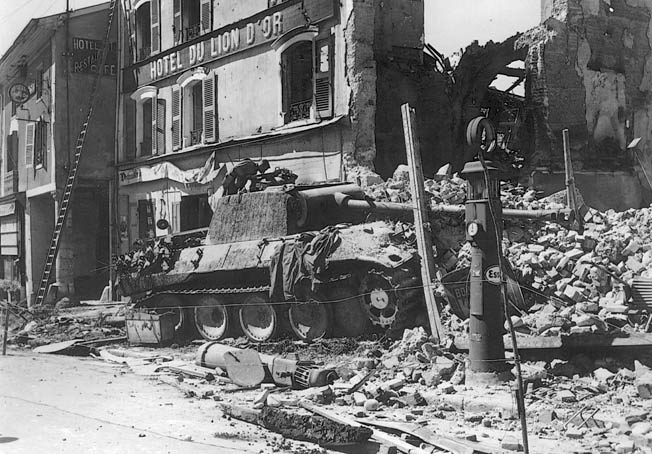
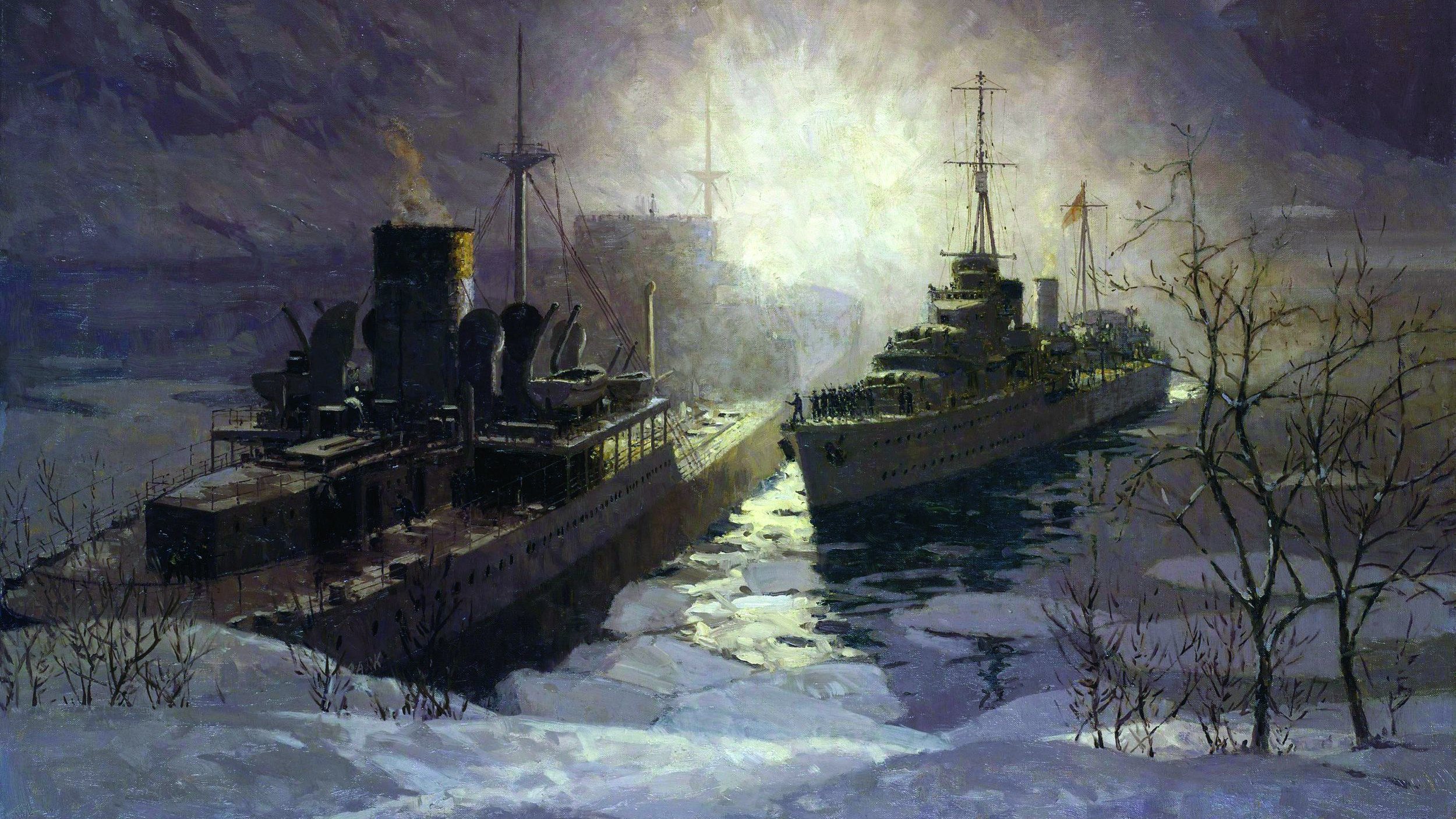
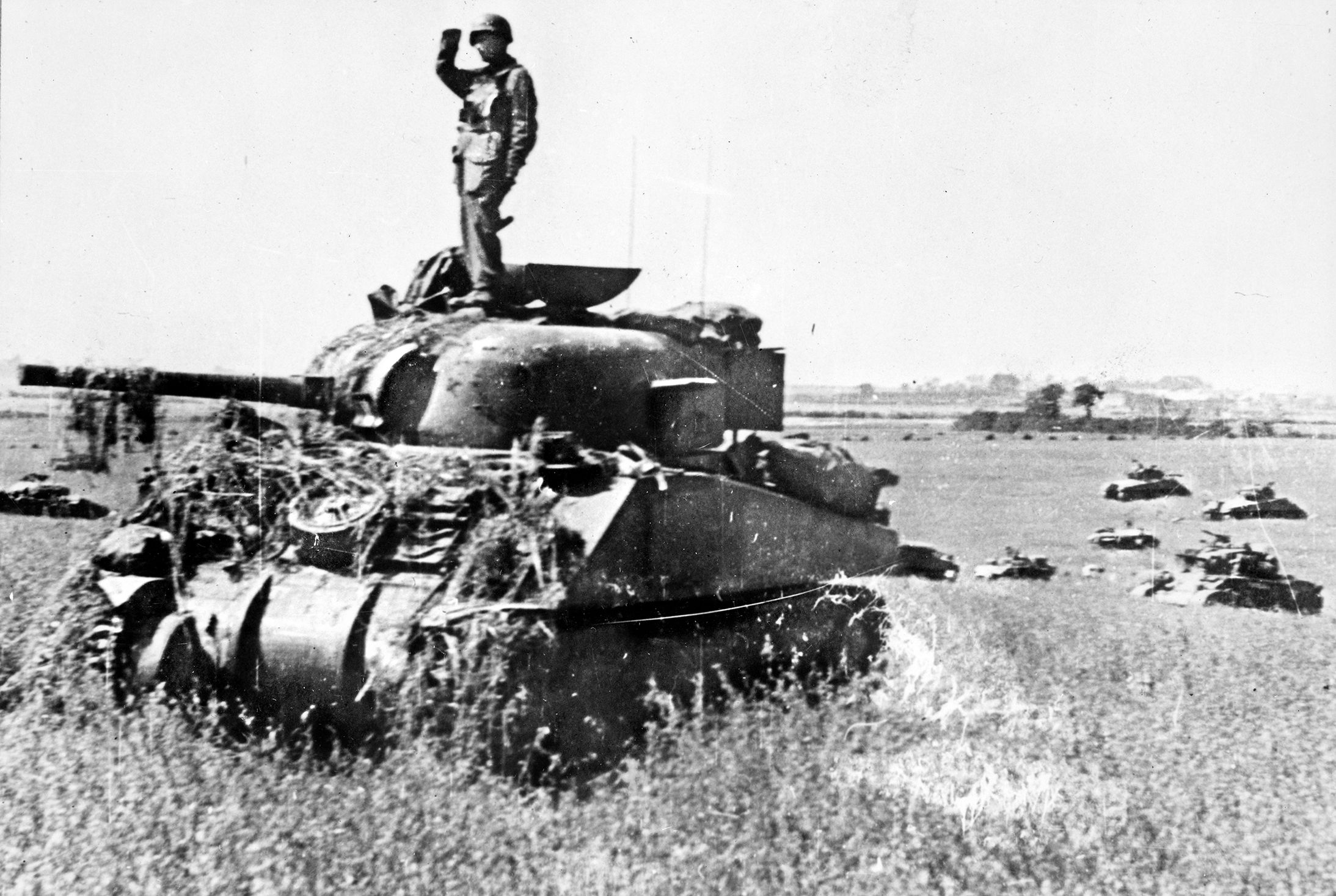
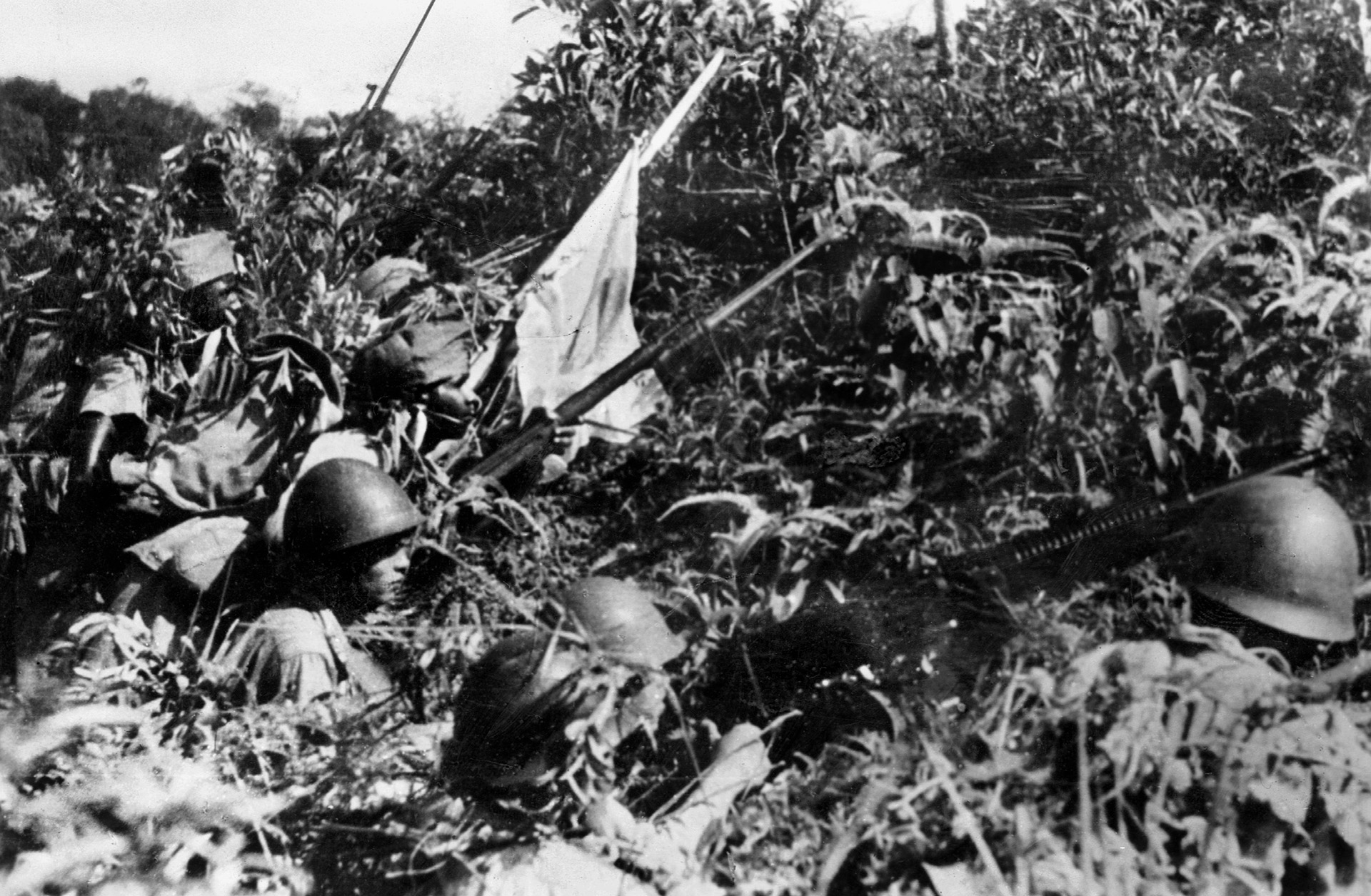
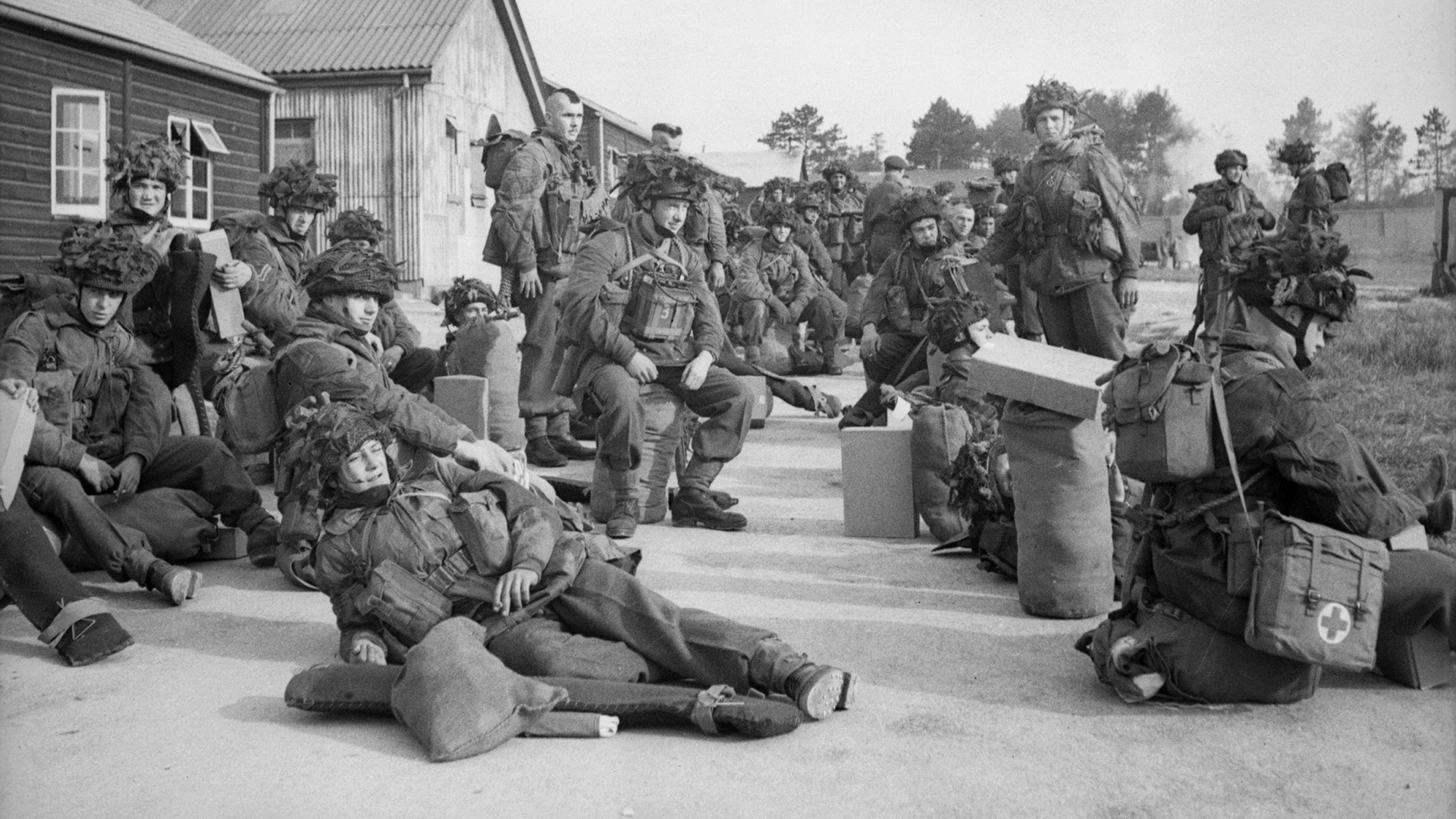

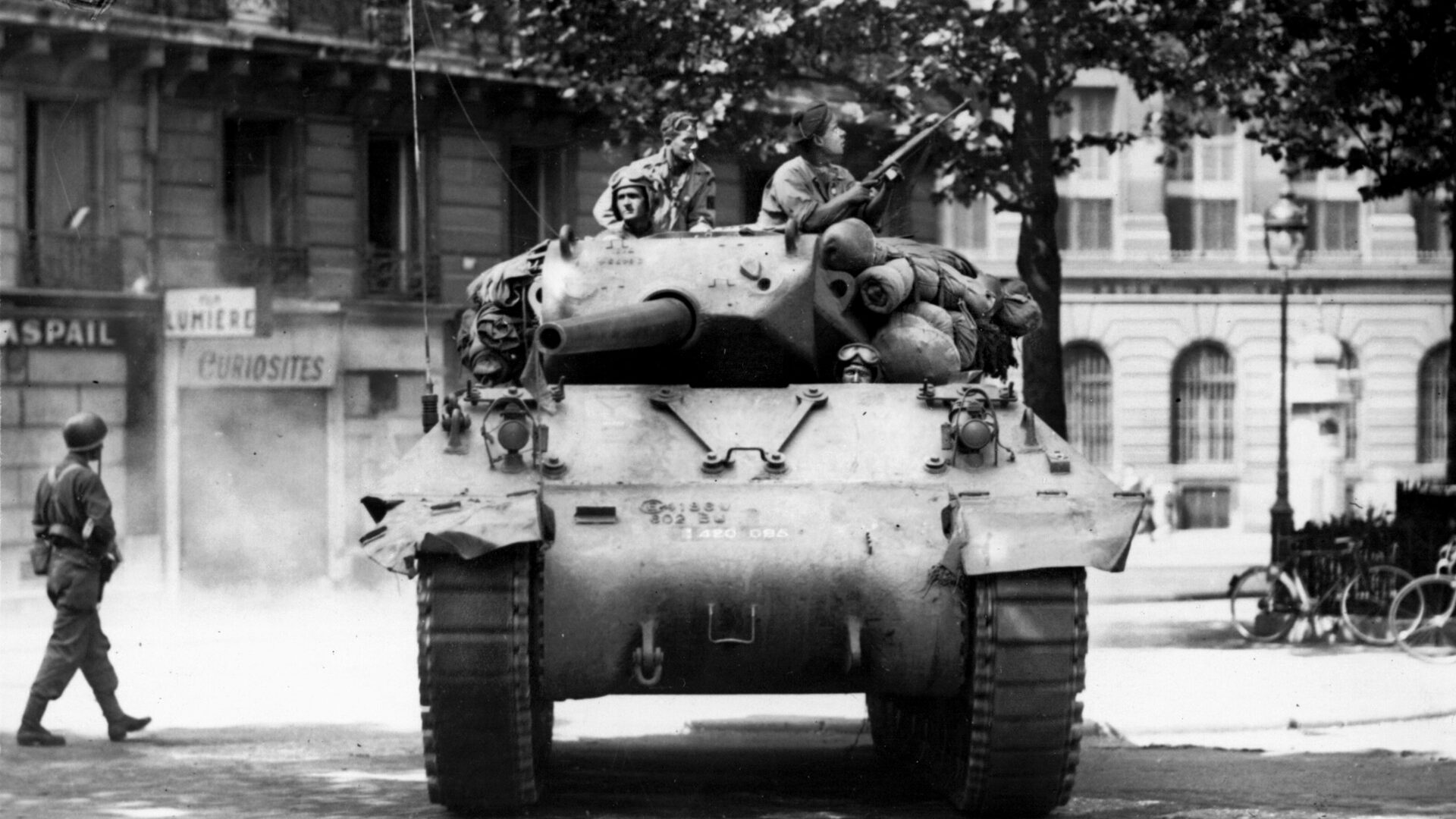
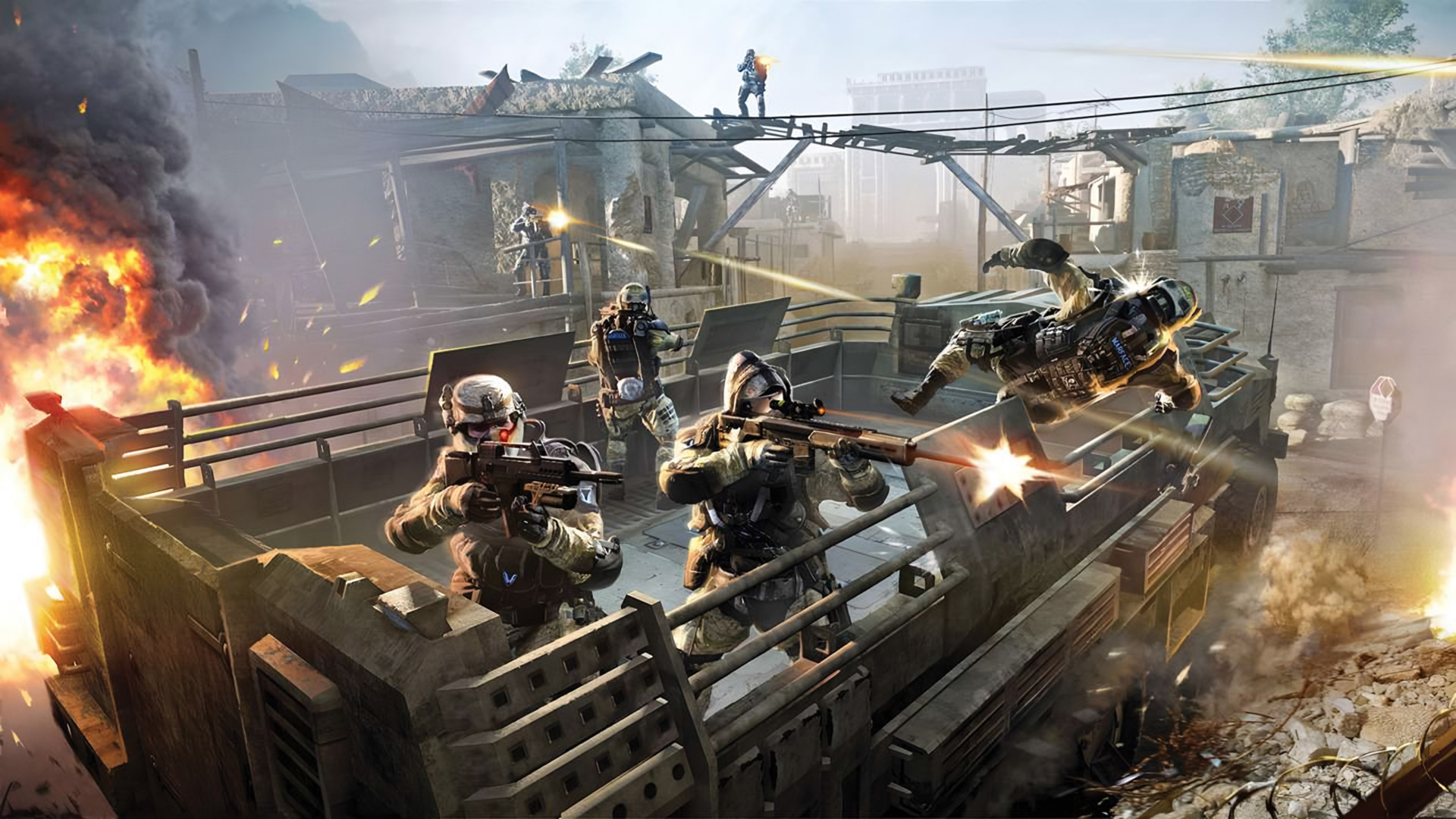
Mr. Flintlock, my uncle was a Captain fighting under Col. Davison. He was with the 179th from Sicily to Epinal. He received two silver stars and I believe received a third at Merimieux. I’m trying to research the third.
Unbelievable tales of bravery and anti nazi courage!!!
Greg Block,
Our WWII 45th Infantry Division Group:
https://www.facebook.com/groups/WW2Thunderbirds/
might be able to help you.
Bronze Star awards are listed on a soldier’s discharge and in General Orders.
We can help you research your uncle’s discharge or the general orders with his bronze stars.
Leonard H. Cizewski
Co-administrator, The 45th Infantry Division in World War II: An Unofficial Guide to Resources
and son of the late Felix A. Cizewski
45th Signal Company, January to September 1945
Wow. Never even heard of this battle until today. Thanks!